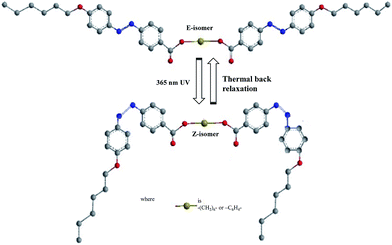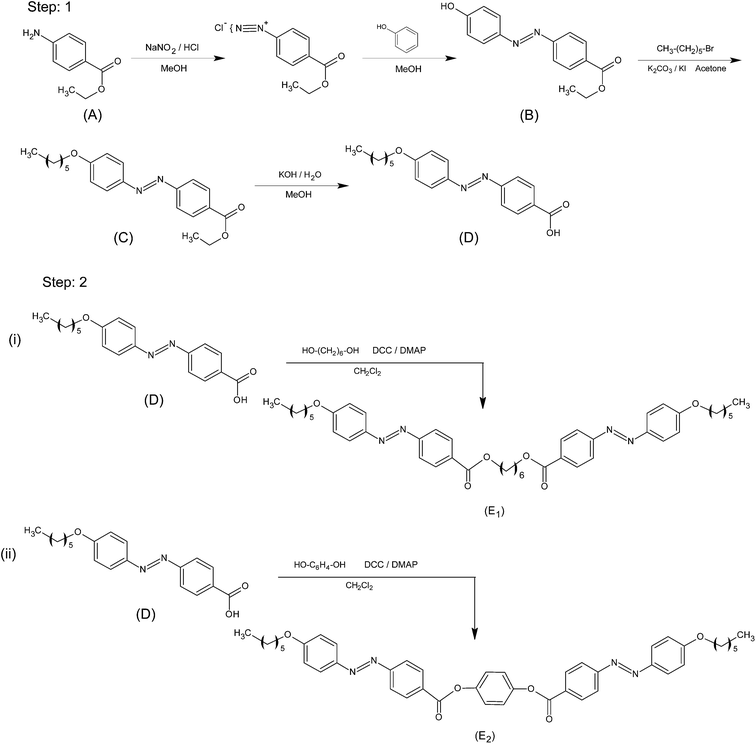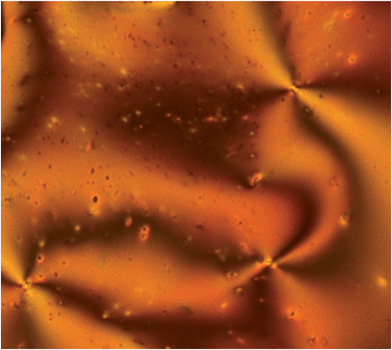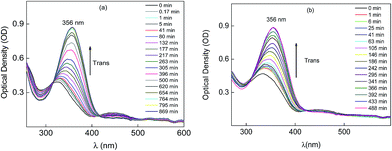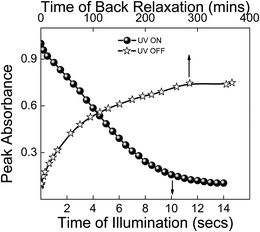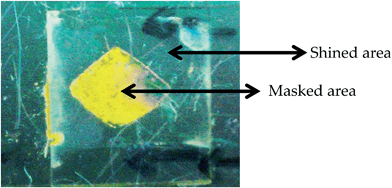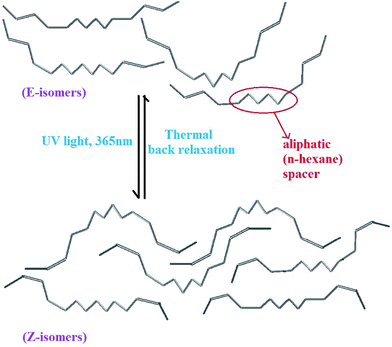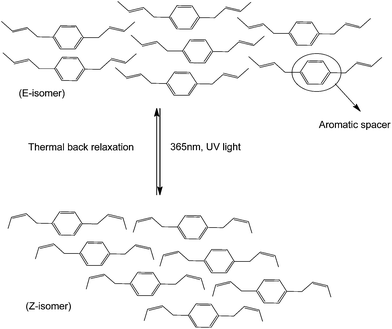Aliphatic/aromatic spacers based azo dye dimers: synthesis and application for optical storage devices†
A. R. Yuvaraj,
Gan Siew Mei,
Ajaykumar D. Kulkarni,
M. Y. Mashitah and
Gurumurthy Hegde*
Faculty of Industrial Sciences and Technology, Universiti Malaysia Pahang, 26300, Gambang, Kuantan, Malaysia. E-mail: murthyhegde@gmail.com
First published on 18th September 2014
Abstract
The photoisomerization effect of new bent-shaped azo dyes in the presence of aliphatic and aromatic spacers is reported for the first time. The synthesized compounds with n-hexane and benzene as central moieties were characterized by different spectral analytical techniques such as 1H-NMR, 13C-NMR, FTIR and UV-Vis. They revealed the photoisomerization effect in solution and on the solid cells as well. In solution, the E–Z and Z–E isomerization occurred in around 17–18 seconds and 7–13 hours, respectively. The dramatic variation in back relaxation is speculated to take place due to the nature of the spacers involved in the system. The synthesized materials are expected to be more useful in optical storage devices.
1. Introduction
An optical storage device is a system that is used to save information by light illumination. There are a number of light sensitive organic compounds that have been employed to fabricate information storage devices. The performance of any optical storage device depends on the chemical structure of the compounds as well as properties of illuminated UV light.1,2 The light sensitive groups, mainly chromophores, are responsible for the photoisomerization and reorientation of molecules.3–5 Among chromophores, azo dyes are good candidates for studying light-induced properties, which in turn makes it possible to create optical storage devices, due to their highly sensitive photoisomerization nature.1Azo dyes with different structures have been studied extensively for photoisomerization and liquid crystalline behaviour by many groups.2–4 The first examples of bent core azobenzene molecules were studied by Vorländer et al.6 Moreover, there has been a lot of interest in banana-shaped liquid crystal azo dyes due to their unique photo switching and electro-optic behaviour.7,8 Prasad et al. reported quite interesting photo responsive behaviour of banana-shaped azo dyes.9
It is not always true that all banana-shaped azo dyes are liquid crystalline in nature, but it is interesting to study these azo dyes as guest–host systems in the liquid crystalline media. The main reason for using azobenzene molecules in the chemical structure is because of the system of molecules, which allows delocalized electronic charge distribution between donor and acceptor groups at both sides of the π-system. Moreover, an interesting feature of the azo group is the trans–cis isomerization by light absorption. In the field of liquid crystals, this property might be very useful, especially in the area of holographic media,10 optical storage11 and photo-alignment of LC systems.12 Moreover, these bent molecules are symmetric in nature, and in these bow-shaped molecules, “spacers” affect the photoisomerization to a significant extent.13
On the other hand, the photoisomerization of azo dyes generally varies with structure, different functional groups and spacers. Note that different spacers give different characteristics to the compounds.14 It is quite interesting to study the back relaxation time based on aliphatic/aromatic spacers. To the best of our knowledge, the dramatic influence of aliphatic/aromatic spacers on dimeric azo dyes has not been studied to date. The energetically more stable trans configuration will turn into the cis configuration when UV light of wavelength 365 nm shines on azobenzene systems and reversion to the original configuration is brought about either by keeping it in the dark (well known as thermal back relaxation) or by illuminating with white light of higher wavelength (say 450 nm), as shown in Fig. 1.
Here, in this study, we investigated the optical properties of the bent-shaped azo dye compounds, which might induce dramatic changes in the photoisomerization of dimeric azo dyes because of the spacer effect. Our newly synthesized compounds are good candidates for photoswitching studies as well as information storage devices.
2. Experimental details
A detailed synthesis scheme for synthesizing dimeric azo dyes with aliphatic and aromatic spacers is shown in Fig. 2.2.1. Materials and methods
Ethyl 4-amino benzoate (Fluka), sodium nitrite (Fluka), phenol (Merck), 1-bromohexane (Fluka), potassium hydroxide (Fluka), potassium iodide (Fluka), potassium carbonate (Aldrich), hydroquinone (Fluka), aniline (Fluka), 1,3-dicyclohexylcarbodiimide (DCC) (Fluka), 4-(N,N-dimethylamino)pyridine (DMAP) (Fluka), 4-nitroaniline (Fluka), 4-aminoacetophenone, 1,6-dibromo hexane and silica gel-60 (Merck) were used. Acetone was dried over phosphorus pentoxide (Merck) and dichloromethane was dried over calcium hydride (Fluka) and distilled before use. Other solvents and chemicals were used as provided.The synthetic procedures were obtained from previously reported studies16–20 and the procedures were modified according to reactions.
The structures of the intermediates and desired products were confirmed by spectroscopic methods: IR spectra were recorded using a Perkin Elmer (670) FTIR spectrometer and 1H NMR (400 and 500 MHz) and 13C NMR (100 MHz) using Bruker; CHN elemental analyser using Leco & Co. Optical textures were obtained by using Olympus BX 51 polarizing optical microscope equipped with a Linkam hot stage. The photo-switching study was performed by recording UV-Vis absorption spectra using a UV-Visible spectrophotometer obtained from Ocean Optics (HR2000+). For photo-switching studies in solutions, photo-switchable azo dyes were dissolved in chloroform at concentrations of C = 1.1 × 10−5 mol L−1. Photoisomerization of these compounds were investigated by illuminating with an OMNICURE S2000 UV source that was equipped with a 365 nm filter and heat filter to avoid heat radiations, arising from the source to the sample. Photoswitching studies were also performed in solid cells, where 5% of guest azo dyes were mixed with 95% host liquid crystal and the mixture was filled using the capillary method in previously prepared ITO coated cells with unidirectionally rubbed polyimide layers. Cell thickness was fixed at around 5 μm, and host liquid crystal used was room temperature nematic liquid crystals MLC 6873-100, exhibiting isotropic temperature around 80 °C.21,22,23
2.2. Ethyl 4-(4-hydroxyphenyl azo) benzoate (B)
Compound A (46.00 mmol, 1 equiv.) was dissolved in methanol (40 ml), and the solution was cooled to 2 °C. 25% HCl was added drop wise (8.672 ml) to the reaction mixture while still maintaining the temperature at 2 °C. NaNO2 was dissolved with water (44.6 mmol, 1 equiv.) and added drop wise at 2 °C, and the reaction mixture was stirred for 15 min. Phenol solution was prepared with methanol (44.6 mmol, 1 equiv.) and added slowly at 2 °C, and the pH was elevated to 8.5–9.0 by using 1 N NaOH solution. The reaction mixture was agitated for 4 hours, and then diluted with methanol (250 ml) and ice. The pH was then reduced to 4, and the reddish yellow precipitate was filtered and dried. The crude product was recrystallized twice from methanol.A red coloured solid; Rf = 0.42 (40% CH2Cl2–EtOH); yield: 62%; melting point: 160.2 °C; IR (KBr) cm−1: 3321, 1728, 1602, 1484, 1248, 1140, 829; 1H NMR (400 MHz, acetone-d6): δ 8.17 (d, J = 8.2 Hz, 2H, Ar), δ 7.92 (d, J = 7.5 Hz, 2H, Ar), δ 7.88 (d, J = 7.5 Hz, 2H, Ar), δ 7.01 (d, J = 8.2 Hz, 2H, Ar), δ 5.54 (s, 1H, OH), δ 4.42 (q, J = 7.2 Hz, 2H, CH2CH3), δ 1.44 (t, 3H, CH2CH3); 13C NMR (100 MHz, acetone-d6): δ 160.7, 145.3, 157.0, 132.3, 116.2, 124.4, 122.9, 130.2, 165.9, 60.9, 14.1; MS (FAB+): m/z for C15H14N2O3, calculated: 270.28. Found: 270.08; elemental analysis: calculated (found) %: C 66.66 (66.74), H 5.22 (5.16), N 10.37 (10.31), O 17.61 (17.67).
2.3. Ethyl 4-[4-(4-hexyloxy)phenylazo] benzoate (C)
Compound B (18.5 mmol, 1 equiv.) and 1-bromohexane (37.1 mmol, 2 equiv.) were dissolved in dry acetone (300 ml). Then, potassium carbonate (18.5 mmol, 1 equiv.) was added drop wise by using an addition funnel. A catalytic amount of potassium iodide (50 mg) was added to the reaction mixture. Then, the reaction mixture was refluxed for 24 hours under a nitrogen atmosphere, and the reaction was monitored by TLC to confirm its completion. The reaction mixture was taken out and the solvent evaporated inside a fume hood. Note that the dried reaction mixture was taken for the next step, i.e., ester hydrolysis reaction.2.4. 4-[4-(4-hexyloxy)phenylazo] benzoic acid (D)
Compound C was used as such after confirmation using TLC. It was dried and dissolved in 100 ml of methanol. The reaction mixture was cooled below 5 °C by using an ice bath, and a solution of potassium hydroxide (62.2 mmol, 3 equiv.) in water (20 ml) was added dropwise. Then, the reaction mixture was refluxed for 4 hours, and the reaction was monitored by TLC to confirm its completion. The reaction mixture was taken in a separating funnel, and then it was washed two times with n-hexane to remove nonpolar impurities. Then, the aqueous solution was acidified with dilute hydrochloric acid and the pH was adjusted exactly to 6.0. Subsequently, the compound was extracted with ethyl acetate, followed by washing with brine solution, and anhydrous sodium sulphate was added to remove the water content. The solid product was collected from the solution by evaporating ethyl acetate using a rotatory evaporator and recrystallizing from ethanol![[thin space (1/6-em)]](https://www.rsc.org/images/entities/char_2009.gif) :
:![[thin space (1/6-em)]](https://www.rsc.org/images/entities/char_2009.gif) chloroform (2
chloroform (2![[thin space (1/6-em)]](https://www.rsc.org/images/entities/char_2009.gif) :
:![[thin space (1/6-em)]](https://www.rsc.org/images/entities/char_2009.gif) 1).
1).
A dark yellow coloured solid; yield: 46%; IR (KBr) cm−1: 2849, 2918, 3004, 1711, 2918, 1220, 1588, 1493, 1248, 1130, 1092, 835; 1H NMR (400 MHz, DMSO): δ 10.46 (s, 1H, COOH), δ 8.12 (d, J = 8.45 Hz, 1H, Ar), δ 7.85 (d, J = 8.80 Hz, 1H, Ar), δ 7.15 (d, J = 8.95 Hz, 1H, Ar), δ 6.97 (d, J = 8.24 Hz, 1H, Ar), δ 4.098 (t, J = 13.05 Hz, 2H, OCH2), δ 1.82 (t, 2H, CH2), δ 1.37 (t, 2H, CH2), δ 1.27 (h, 2H, CH2), δ 1.25 (q, 2H, CH2), δ 0.86 (t, 3H, CH3); 13C NMR (100 MHz, acetone-d6): δ 161.6, 144.3, 157.9, 132.4, 114.7, 123.6, 122.9, 130.6, 68.7, 29.6, 25.6, 31.8, 22.7, 14.1; MS (FAB+): m/z for C19H22N2O3, calculated: 326.39. Found: 326.09; elemental analysis: calculated (found) %: C 69.92 (69.98), H 6.79 (6.70), N 8.58 (8.49), O 14.38 (14.45).
2.5. 1,6-Hexylene bis-{4-[4-(4-hexyloxy) phenylazo]benzoate} (E1)
Compound D (15.3 mmol, 1 equiv.) was dissolved in 50 ml of dry dichloromethane. DMAP (1.40 mmol, 0.1 equiv.) was added and the mixture was stirred for 30 min. A solution of 1,6-dibromohexane (7.6 mmol, 0.5 equiv.) in dry dichloromethane (10 ml) was added to the mixture, and then DCC (23.0 mmol, 1.5 equiv.) in 10 ml of dry dichloromethane was added slowly. The mixture was stirred for 24 hours, and the reaction was monitored by TLC. After completion of the reaction, the precipitate was removed by filtration and the filtrate was quenched with 1.5 N hydrochloric acid. The compound was extracted two times with dichloromethane, and then it was washed with 1 N sodium hydrogen carbonate, followed by brine. The water content was removed by adding anhydrous sodium sulphate. Finally, the solid crude product was collected by evaporating dichloromethane using a rotatory evaporator. The obtained product was purified by column chromatography using chloroform![[thin space (1/6-em)]](https://www.rsc.org/images/entities/char_2009.gif) :
:![[thin space (1/6-em)]](https://www.rsc.org/images/entities/char_2009.gif) methanol (20
methanol (20![[thin space (1/6-em)]](https://www.rsc.org/images/entities/char_2009.gif) :
:![[thin space (1/6-em)]](https://www.rsc.org/images/entities/char_2009.gif) 1) as eluent. The product was recrystallized from methanol
1) as eluent. The product was recrystallized from methanol![[thin space (1/6-em)]](https://www.rsc.org/images/entities/char_2009.gif) :
:![[thin space (1/6-em)]](https://www.rsc.org/images/entities/char_2009.gif) chloroform (2
chloroform (2![[thin space (1/6-em)]](https://www.rsc.org/images/entities/char_2009.gif) :
:![[thin space (1/6-em)]](https://www.rsc.org/images/entities/char_2009.gif) 1) to obtain the target compound E1.
1) to obtain the target compound E1.
E1: a pale yellow coloured solid; yield: 35%; melting point is 154.2 °C; IR (KBr) cm−1: 1730 (C![[double bond, length as m-dash]](https://www.rsc.org/images/entities/char_e001.gif) O), 1240 (C–O–C), around 1500 (Ar C
O), 1240 (C–O–C), around 1500 (Ar C![[double bond, length as m-dash]](https://www.rsc.org/images/entities/char_e001.gif) C) along with other C–C, C–H absorption bands; 1H NMR (500 MHz, CDCl3): δ 0.92–1.85 (m, 30H, aliphatic-H), 4.08 (t, 4H, J = 6.5 Hz, ether–CH2), 4.37 (t, 4H, J = 10 Hz, ester–CH2), 8.4–6.9 (m, 16H, Ar–H); 13C NMR (100 MHz, CDCl3): δ 14.0–33.9 (aliphatic C), 114.79–136.12 (Ar–C); MS (FAB+): m/z for C44H54N4O6, calculated: 734.92. Found: 734.40; elemental analysis: calculated (found) %: C 71.91 (71.85), H 7.41 (7.22), N 7.62 (7.57), and O 13.06 (12.99).
C) along with other C–C, C–H absorption bands; 1H NMR (500 MHz, CDCl3): δ 0.92–1.85 (m, 30H, aliphatic-H), 4.08 (t, 4H, J = 6.5 Hz, ether–CH2), 4.37 (t, 4H, J = 10 Hz, ester–CH2), 8.4–6.9 (m, 16H, Ar–H); 13C NMR (100 MHz, CDCl3): δ 14.0–33.9 (aliphatic C), 114.79–136.12 (Ar–C); MS (FAB+): m/z for C44H54N4O6, calculated: 734.92. Found: 734.40; elemental analysis: calculated (found) %: C 71.91 (71.85), H 7.41 (7.22), N 7.62 (7.57), and O 13.06 (12.99).
A similar procedure is followed to synthesize the compound E2.
E2: a pale yellow colored solid; yield: 35%; melting point is 124.3 °C; IR (KBr) cm−1: 1735 (C![[double bond, length as m-dash]](https://www.rsc.org/images/entities/char_e001.gif) O), 1245 (C–O–C), Around 1500 (Ar C
O), 1245 (C–O–C), Around 1500 (Ar C![[double bond, length as m-dash]](https://www.rsc.org/images/entities/char_e001.gif) C) along with other C–C, C–H absorption bands; 1H NMR (500 MHz, CDCl3): δ 0.84–1.78 (m, 22H, aliphatic-H), 6.93–8.28 (m, 20H, Ar–H), 3.985 (t, 4H, J = 8.5 Hz, ether–CH2); MS (FAB+): m/z for C44H46N4O6, calculated: 726.86. Found: 726.32; elemental analysis: calculated (found) %: C 72.71 (72.78), H 6.38 (6.31), N 7.71 (7.66), and O 13.21 (13.17).
C) along with other C–C, C–H absorption bands; 1H NMR (500 MHz, CDCl3): δ 0.84–1.78 (m, 22H, aliphatic-H), 6.93–8.28 (m, 20H, Ar–H), 3.985 (t, 4H, J = 8.5 Hz, ether–CH2); MS (FAB+): m/z for C44H46N4O6, calculated: 726.86. Found: 726.32; elemental analysis: calculated (found) %: C 72.71 (72.78), H 6.38 (6.31), N 7.71 (7.66), and O 13.21 (13.17).
3. Results and discussion
Azo dyes were prepared by diazotisation, followed by phenol coupling, and then etherification and hydrolysis by employing 4-ethylamino benzoate as a starting material. Aliphatic and aromatic spacers were introduced into the molecule by DCC coupling, in which dimerization of azo dyes takes place. This gives rise to bent-shaped azo dyes E1 and E2. The synthesized compounds were confirmed by FTIR, 1H and 13C NMR, elemental analysis and mass spectroscopy studies. The elemental analysis results are in accordance with the NMR results.3.1. Mesophase characterization
Table 1 indicates the transition temperature range of the compounds in heating and cooling cycles. One can notice from the table that the synthesized compounds form liquid crystalline nematic phases. The nematic textures were observed with a polarizing optical microscope, as shown in Fig. 3, and the cooling rate is fixed at 2 °C minute−1.| Compounds | Scan | Phase transition (°C) |
|---|---|---|
| E1 | Heat | Cr 134.5 N 236.1 I |
| Cool | I 236.1 N 134 Cr | |
| E2 | Heat | Cr 168.2 N 245.6 I |
| Cool | I 245.6 N 164.3 Cr |
3.2. Photoswitching properties
Photo-switching studies of our two synthesized azo dyes showed similar absorption spectra with peaks at ∼357 nm, due to their similar molecular structures. The only difference between the two compounds is the spacers at the central moiety, which are responsible for elasticity, flexibility and free rotation. The absorption spectra of compounds E1 and E2 are shown in Fig. 4.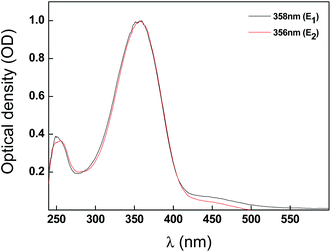 | ||
| Fig. 4 The absorption spectra of E1 and E2 were measured with the solutions at C = 1.1 × 10−5 mol L−1 by using a UV-Vis spectrophotometer. | ||
Photoswitching studies were initially performed on solutions and then with solid cells. These studies provide an idea of the behaviour of the materials with respect to UV light and these results are indispensable for creating optical storage devices.24,25
Fig. 5a and b depicts the E–Z isomerization absorption spectra of E1 and E2, respectively, before and after UV illumination. The absorption spectra of the compounds show absorption maxima at 358 nm and 356 nm. The absorption spectra of the compounds were obtained in chloroform (CHCl3) and the concentration of each solution was fixed at C = 1.1 × 10−5 mol L−1. The strong absorbance in the UV region at ∼357 nm corresponds to π–π* transition of the E isomer (trans isomer), whereas a very weak absorbance in the visible region is at around ∼450 nm represents n–π* transition of the Z isomer (cis isomer).
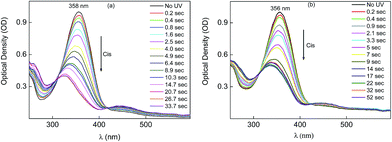 | ||
| Fig. 5 E to Z conversion of E1 (a) and E2 (b) in solution by shining UV light with a 365 nm filter and heat filter. | ||
The photo-switching properties of E1 and E2 were investigated with UV light illumination of intensity 5.860 mW cm−2. The compounds were illuminated with UV light having a 365 nm filter and heat filter, at different time intervals and the absorption spectra were recorded immediately.26–28 The absorption maxima decreased, due to E–Z photoisomerization, which led to the transformation of E isomers into the Z isomers. The photosaturation of these compounds are 17 s and 18 s, respectively.
Fig. 6 shows the E–Z absorption of compounds E1 and E2 as a function of exposure time. The data were extracted from Fig. 5a and b by considering the peak wavelengths of 358 nm and 356 nm, respectively, as a function of exposure time. The absorption values of these peak wavelengths with different exposure times were recorded. The curve shows that the phase involving photoisomerization occurs within 17–18 s.
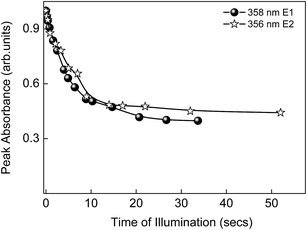 | ||
| Fig. 6 The peak absorbance of E1 and E2, extracted from Fig. 5, with respect to the function of exposure time for E–Z isomerization. | ||
The conversion efficiency (CE), which is also called the extent of isomerization of the E–Z photoisomerization, was estimated from the following equation:15
The extent of isomerization in these compounds is shown in Table 2. In other words, the extent of isomerization varies in the presence of different spacers: compound E1 has 76% and compound E2 has only 55% of extent of isomerization. This effect is due to the nature of the spacers, length of the spacers and free rotations, and the reason for this behaviour is explained in the later sections.
| Compounds | Extent of isomerization (%) |
|---|---|
| E1 | 76 |
| E2 | 55 |
The reverse transformation from Z to E can be brought about by two methods: first method is by keeping the solution in the dark, a process called thermal back relaxation, and the other method is by shining white light of higher wavelength. Fig. 7a and b shows the thermal back relaxation process, in which the solution is illuminated continuously for 30 seconds (much higher than the photostationary state) and kept in a dark place. Then, spectral data were recorded at subsequent time intervals.29,30 The back relaxation of compounds E1 and E2 are 13.21 hours and 7.25 hours, respectively.
Fig. 8 shows the time dependent Z–E absorption spectra of the compounds presented here, which is obtained from Fig. 7a and b.
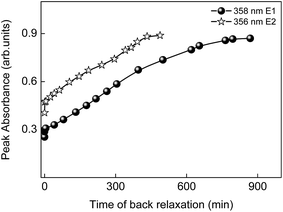 | ||
| Fig. 8 The peak absorbance of E1 (a) and E2 (b), extracted from Fig. 7, with respect to the function of recovery time for Z–E isomerization. | ||
Peak wavelength was fixed at ∼357 nm and absorbance plotted as a function of recovery time. A possible reason for the difference in thermal back relaxation as well as the UV ON process could be the properties of the spacers present in the middle of the molecules, and the change that occurs is confined to in-plane rotation of the molecules. The optical activity of the compounds will change significantly due to the effect of spacers;4 hence, the synthesized compounds show different intervals of photosaturation and thermal back relaxation.
Spectral investigations on solid cells were performed on the sample E1 because it showed high conversion efficiency of E–Z in solution, which can be seen in Fig. 9.
Commercial liquid crystal was used as the host material and it was mixed with guest material E1. The cell was constructed by ITO glass plates precoated with polyamide and rubbed unidirectionally. 5% of E1 (guest molecules) were dissolved in 95% of commercial liquid crystal “MLC6873-100” (host molecules). The mixture was capillary filled in the previously prepared liquid crystal cell of thickness 5 μm via capillary action at isotropic phase (∼100 °C). Similar to the solution illumination, solid cells were also illuminated with UV light of wavelength 365 nm and the photosaturation was found at 10 s and complete thermal back relaxation was observed at 382 min with intensity 5.860 mW cm−2. Therefore, E1 shows good optical activity and is a good candidate for optical storage devices.
Optical storage devices based on the above concept are presented using the abovementioned materials. Thickness of the cell is fixed at around 5 mm, whereas sandwiched and previously ITO coated rubbed polyimide layers were used for making the prototype. Guest-host mixture in which liquid crystal host is mixed with azo-dye guest molecule were filled inside the cell at isotropic temperature. Dark regions shown in Fig. 10 belong to the illuminated area where materials change from ordered to disordered states, whereas bright regions are the masked area where material remains in the nematic phase.
3.3. Effect of spacer
We now discuss the effect of spacers on the dramatic variation of photoisomerization.In Table 3, there is a clear description of the difference in photosaturation and thermal back relaxation for E1 and E2. The possible reason for this behaviour must be the effect of spacers. The dimers show long time back relaxation in photoisomerization. Dimers with aromatic spacers exhibited shorter time thermal back relaxation than aliphatic dimeric azo dyes. The aromatic/aliphatic spacers affect the free movement of the molecules to a significant extent. There are two different cases that can explain the material properties of E1 and E2.
Case 1: consider the compound E1. In between the two azo moieties, there is an aliphatic chain (n-hexane) present, as shown in Fig. 11.
The molecules can have different structures due to the flexible movement of the carbon chain, which can result in a restriction of the isomerization. In this case, E–Z isomerization takes place with illumination of UV light with the wavelength of ∼365 nm and the photoisomerization is a little slower due to the presence of long chain aliphatic spacers. The time required for photosaturation is 17 s and thermal back relaxation time is 13.25 hours. The flexibility of the molecules prevents the system from going back easily by forming a coiled geometry, and somewhat similar results on long chain alkanes were reported earlier.14
Case 2: now, consider the compound E2. In between the two azo moieties, there is an aromatic benzene ring present, as shown in Fig. 12. Due to the rigidity of the benzene ring, the molecules are not bending as much as in the case of the aliphatic spacers. Apart from the E–Z isomerization of the benzene ring, there is no appreciable change in the molecular structure of E2 after the E–Z isomerization. In this case, the photoisomerization is relatively faster due to the presence of aromatic benzene spacers. Time required for photosaturation is 18 s, whereas for thermal back relaxation, it is 7.21 hours. It is obvious that time taken for the molecules to achieve photosaturation is almost same in both cases, because they are radiation-induced processes. Note that thermal back relaxation is a completely radiation free process and it depends on the structural modifications; therefore, the aromatic spacers are giving back relaxation faster due their rigidity, whereas the long chain aliphatic spacers relax slower than their aromatic counterparts due their flexibility. More investigation is in progress to study the different kinds of azo dye spacers and their effects under UV light and will be reported elsewhere.
4. Conclusion
Two new dimeric azo dyes with different spacers were synthesized. They exhibit the nematic phase as evidenced by polarizing optical microscopy. The presence of spacers in the molecules plays an important role in photoisomerization. The extent of the isomerization is less in the presence of aromatic spacers than with aliphatic spacers because of the restriction to free rotation and inflexibility, caused by the aromatic groups. Moreover, these compounds are suitable for photochromism studies under UV irradiation. It is clear that the effect of spacers is considerable in the study of optical properties of the compounds and the insertion of aromatic spacers generates a dramatic change. The photoswitching properties of compounds E1 and E2 show E–Z isomerization at around 17 s and 18 s, respectively, whereas the reverse process takes place at around 7.21 hours for E2 and 13.25 hours for E1 in solution. Solid study showed E–Z photoisomerization takes around 10 s for E1 and the reverse to the original Z–E takes around 382 min. Thus, the photoswitching behavior of these materials E1 and E2 may be suitably exploited in the field of optical data storage devices and in molecular switches.Acknowledgements
We acknowledge the Ministry of Science and Technology Industry MOSTI for providing e-Science fund RDU 130503 and also the Ministry of Education for providing ERGS grant RDU 131408.Notes and references
- M. L. Rahman, H. Gurumurthy, M. M. Yusoff, M. N. F. A. Malek, H. T. Srinivasa and S. Kumar, New J. Chem., 2013, 37, 2460 RSC.
- H. M. D. Bandara and S. C. Burdette, Chem. Soc. Rev., 2012, 41, 1809 RSC.
- C. G. Iriepa, M. Marazzi, L. M. Frutos and D. Sampedro, RSC Adv., 2013, 3, 6241 RSC.
- M. L. Rahman, M. M. Yusoff and S. Kumar, RSC Adv., 2014, 4, 35089 RSC.
- R. Dong, B. Zhu, Y. Zhou, D. Yan and X. Zhu, Polym. Chem., 2013, 4, 912 RSC.
- D. Vorländer, Ber. Dtsch. Chem. Ges., 1929, 62, 2831 CrossRef.
- M. R. Lutfor, H. Gurumurthy, S. Kumar, C. Tschierske and V. G. Chigrinov, Opt. Mater., 2009, 32, 176 CrossRef CAS PubMed.
- G. Pelzl, S. Diele and W. Weissflog, Adv. Mater., 1999, 11, 707 CrossRef CAS.
- V. Prasad, S. W. Kang, X. Qi and S. J. Kumar, J. Mater. Chem., 2004, 14, 1495 RSC.
- D. Y. Kim, S. K. Li, L. Tripathy and J. Kumar, Appl. Phys. Lett., 1995, 66, 1166 CrossRef CAS PubMed.
- M. L. Rahman, H. Gurumurthy, M. Azazpour, M. M. Yusoff and S. Kumar, J. Fluorine Chem., 2013, 156, 230 CrossRef CAS PubMed.
- H. Gurumurthy, R. A. Alla, A. Matharu and L. Komitov, J. Mater. Chem. C, 2013, 1, 3600 RSC.
- S. K. Prasad, G. N. Geetha and H. Gurumurthy, Adv. Mater., 2005, 17, 2086 CrossRef CAS.
- G. N. Geetha, S. K. Prasad and H. Gurumurthy, Phys. Rev. E: Stat., Nonlinear, Soft Matter Phys., 2004, 69, 21708 CrossRef.
- G. Barbero, L. R. Evangelista and L. Komitov, Phys. Rev. E: Stat., Nonlinear, Soft Matter Phys., 2002, 65, 41719 CrossRef CAS.
- D. Stewart and C. T. Imrie, Polym., 1996, 37, 3419 CrossRef CAS.
- P. A. Henderson, A. G. Cook and C. T. Imrie, Liq. Cryst., 2004, 31, 1427 CrossRef CAS.
- R. J. Bass, J. Chem. Soc., Chem. Commun., 1976, 7, 225 Search PubMed.
- K. Wahala and T. A. Hase, J. Chem. Soc., Perkin Trans. 1, 1991, 12, 899 Search PubMed.
- T. N. Chan, Z. B. Lu, W. S. Yam, G. Y. Yeap and C. T. Imrie, Liq. Cryst., 2012, 39, 393 CrossRef CAS.
- M. R. Luftor, G. Hegde, S. Kumar, C. Tschierske and V. G. Chigrinov, Opt. Mater., 2009, 32, 176 CrossRef PubMed.
- S. K. Prasad, G. G. Nair and G. Hegde, J. Phys. Chem. B, 2007, 111, 345 CrossRef CAS PubMed.
- A. R. Yuvaraj, W. S. Yam, T. N. Chan, Y. P. Goh and G. Hegde, Spectrochim. Acta, Part A, 2015, 135, 1115 CrossRef CAS PubMed.
- M. L. Rahman, M. M. Yusoff, H. Gurumurthy, M. N. F. A. Malek, N. A. Samah, H. T. Srinivasa and S. Kumar, J. Chin. Chem. Soc., 2014, 10, 1002 Search PubMed.
- M. R. Lutfor, M. M. Yusoff, H. Gurumurthy, M. N. Fazli, A. Malek, N. A. Samah and H. T. Srinivasa, Mol. Cryst. Liq. Cryst., 2013, 587, 41 CrossRef CAS.
- S. S. Jalm, A. Miniewicz, P. Karpinski, U. J. Mikulska and Z. Galewski, J. Mol. Liq., 2012, 168, 21 CrossRef PubMed.
- P. Nayek, S. Ghosh, S. Roy, T. P. Majumder and R. Dabrowski, J. Mol. Liq., 2012, 175, 91 CrossRef CAS PubMed.
- K. Pal, U. N. Maiti, T. P. Majumder, P. Dash, N. C. Mishra, N. Bennis and J. M. Otón, J. Mol. Liq., 2011, 164, 233 CrossRef CAS PubMed.
- Ö. Polat, N. Yildiz and S. E. San, J. Mol. Liq., 2011, 163, 153 CrossRef PubMed.
- J. C. D. Cuadros, L. L. López, R. J. R. González, B. Donnio, D. Guillon and D. N. Rodríguez, J. Mol. Liq., 2010, 157, 133 CrossRef PubMed.
Footnote |
| † Electronic supplementary information (ESI) available: The spectroscopic data and characterization are given in SI. They are FTIR, 1H-NMR, 13C-NMR, etc. See DOI: 10.1039/c4ra08219b |
| This journal is © The Royal Society of Chemistry 2014 |

